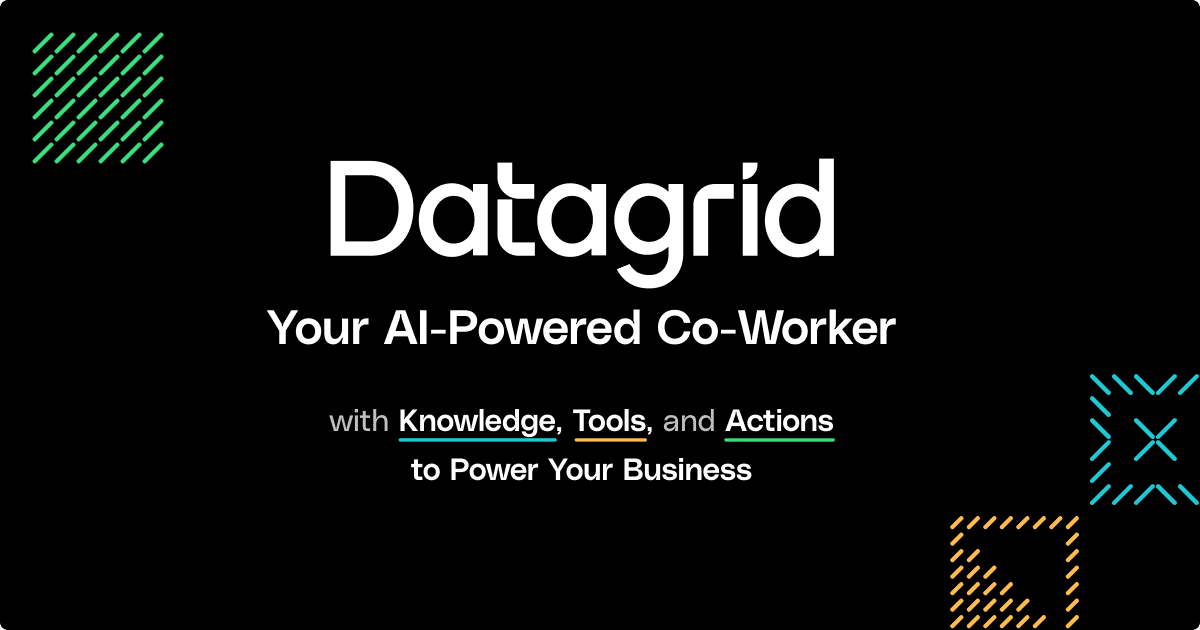All Posts
Productivity tools and techniques
How to Automate Insurance Data Extraction: Methods, Tools & Best Practices

This article was last updated on January 21, 2025
Insurance companies juggle enormous amounts of documentation daily—ranging from claims forms to policy applications—leading to frequent bottlenecks that drive up operational costs. Manual data extraction remains one of the most labor-intensive tasks, with teams often devoting countless hours to reviewing and validating information.
However, recent breakthroughs in Agentic AI have revolutionized how organizations overcome these hurdles. By leveraging Datagrid's intelligent data connectors, insurers can now automate document processing with remarkable speed and precision.
Our comprehensive guide explores how to automate insurance data extraction, covering essential aspects from understanding different document types to integrating advanced extraction technologies and measuring their impact—so you can streamline workflows, reduce manual errors, and ultimately boost profitability.
Understanding Insurance Document Types and Data Sources
Insurance companies handle large volumes of documents daily, each serving a specific purpose across underwriting, claims management, and compliance. Recognizing the unique requirements of each document type is vital for capturing and validating the right data points.
By customizing your automation workflows to address these varying needs, you can enhance both accuracy and compliance. For instance, when processing a homeowner’s claim for damage, adjusters must reference the policy document to determine coverage eligibility and limits.
Policy Documents and Applications
Policy documents lay out the insurer’s obligations and the policyholder’s rights, making them indispensable during underwriting and claims processes. Key data points typically extracted include:
- Policyholder Information: Name, address, contact details
- Coverage Details: Types of coverage, limits, exclusions
- Premium Information: Total cost, payment schedules
- Policy Dates: Effective dates, renewal terms
- Endorsements: Policy modifications and special provisions
These documents are fundamental to determining exact coverage parameters and identifying any special conditions.
Claims Forms and Supporting Documentation
Claims processing involves multiple documents capturing vital details about incidents and losses. Essential data points include:
- Claim Numbers: Unique identifiers for tracking
- Incident Information: Date, time, location, nature of incident
- Loss Details: Damage descriptions, estimated costs
- Supporting Evidence: Photos, repair estimates, police reports
- Payment Information: Claimed amounts, approved payments
For example, in auto insurance claims, you’ll need to extract data from accident reports, repair estimates, and witness statements to evaluate liability and determine compensation amounts.
Medical Records and Health Information
Health and life insurance notably depend on medical documentation. Data elements often include:
- Patient History: Previous conditions, surgeries, medications
- Treatment Records: Dates of service, procedures, providers
- Diagnostic Information: Test results, specialist reports
- Billing Details: Treatment costs, insurance codes
- Provider Information: Healthcare facility details, physician credentials
Such records are pivotal whether you’re underwriting a new policy or validating a claim, as they confirm the necessity and appropriateness of treatments.
Identity and Verification Documents
Verifying policyholder identities is essential for combating fraud and adhering to regulations. Relevant documents include:
- Government-issued IDs: Driver’s licenses, passports
- Proof of Address: Utility bills, bank statements
- Social Security Numbers: For tax and identity verification
- Employment Records: Income verification, workplace details
- Additional Verification: Age proof, relationship documents
These checks are particularly critical for high-value claims and new applications, helping prevent fraudulent applications and ensuring proper risk assessments.
By understanding distinct document types and their associated fields, you’ll be better equipped to design an automation strategy that captures all necessary information while safeguarding accuracy and compliance.
Key Technologies Enabling Insurance Data Extraction
The insurance sector is undergoing a technological renaissance in data extraction, driven by four core innovations that collectively streamline document-processing workflows. These interrelated technologies are redefining how companies handle and leverage data.
Optical Character Recognition (OCR)
OCR underpins many modern insurance data-extraction processes by transforming various document formats into machine-readable text. It proves invaluable for converting:
- Scanned paper documents
- PDF files
- Handwritten forms
- Policy documents
- Claims documentation
By significantly reducing manual data entry, OCR cuts down on processing time and lowers error rates, making it indispensable for large volumes of claims documents.
Natural Language Processing (NLP)
NLP empowers machines to interpret and understand human language with context. Within insurance operations, NLP excels at:
- Analyzing customer communications
- Processing claims narratives
- Extracting information from unstructured text
- Identifying themes and sentiments
- Supporting data-driven decisions
Innovations such as Retrieval Augmented Generation can further enhance NLP by providing more accurate and context-relevant responses. This capability helps insurers gain deeper insights into customer needs and refine service delivery.
Machine Learning and AI Models
Machine learning algorithms provide the predictive and adaptive intelligence behind modern data-analysis efforts. Their applications include:
- Risk assessment using predictive analytics
- Fraud detection through pattern recognition
- Automated decision-making in underwriting
- Optimized claims processing
- Continuous improvement via self-learning
To fully leverage these benefits, it's essential to understand the various AI agent architectures that underpin these machine learning models. Insurance carriers routinely achieve higher efficiency and lower fraud rates by incorporating machine learning into their workflows.
Intelligent Document Processing (IDP)
IDP merges OCR, NLP, and machine learning into a robust framework for handling a broad array of insurance documents. This all-in-one solution offers:
- Advanced data extraction
- Automated processing for diverse document types
- Exceptional accuracy (up to 99%)
- Smooth handling of both structured and unstructured data
- Real-time processing capabilities
Deployed together, these technologies form a cohesive ecosystem that manages growing data demands while striking a balance between efficiency and compliance.
Step-by-Step Implementation Guide
Successfully transitioning to automated insurance data extraction requires structured planning. Below is a high-level roadmap to guide your migration from manual processes.
Assessment and Planning Phase
Kick off with a thorough evaluation of your existing workflows. Research shows that 88% of small and medium-sized businesses believe automation helps them compete with larger enterprises, highlighting the importance of proper planning.
Start by:
- Interviewing stakeholders to capture requirements and pain points
- Tracing current workflows to pinpoint automation opportunities
- Documenting present processing times and error rates
- Defining measurable objectives (e.g., halving processing time)
- Setting KPIs for success (speed, error reduction, user satisfaction)
Technology Selection and Integration
Match your technology choices to internal needs and resources. Consider:
- Scalability to manage expanding data loads
- Compatibility with current systems and processes
- User-friendliness for widespread adoption
- Strong integration features
- Security and compliance functionality
Adopt a phased rollout:
- Begin with a small pilot in one department
- Gather feedback and validate outcomes
- Refine the strategy
- Extend automation across additional areas
Process Design and Optimization
Build workflows that use automation to achieve speed and accuracy. By streamlining workflows with AI, you can optimize processes for maximum efficiency:
- Document Capture Setup:
- Configure OCR systems for incoming formats
- Define quality thresholds for scans
- Standardize templates for frequent document types
- Data Extraction Rules:
- Establish clear field mappings
- Implement validation protocols
- Develop error handling steps
- Workflow Automation:
- Introduce approval and routing rules
- Set up automated notifications for exceptions
- Formalize escalation procedures
Testing and Quality Assurance
Conduct robust testing:
- Unit Testing:
- Check components individually
- Validate data extraction accuracy
- Confirm correct field mapping
- Integration Testing:
- Verify system interoperability
- Simulate end-to-end processes
- Ensure data flows consistently
- Performance Testing:
- Measure speed under load
- Validate scalability and reliability
Quality-control check involves:
- Accuracy verification
- Response times
- Regulatory compliance
- Error resolution workflows
- Security audits
Training and Deployment
Support successful rollout with training and change management:
- Training Program:
- Provide role-based instruction
- Encourage hands-on learning
- Offer certification paths
- Change Management:
- Regularly communicate progress and updates
- Anticipate user questions and feedback
- Provide transition resources
- Ongoing Support:
- Maintain help desk systems
- Author troubleshooting guides
- Solicit feedback for continuous refinement
Regular monitoring allows you to track performance, capture user input, and identify opportunities for optimization. Staying flexible ensures that the system evolves with your organizational needs, sustaining its value long after rollout.
Overcoming Common Challenges
Data Quality and Accuracy Issues
Poor data quality can derail even the best automation strategies. Incomplete records, inconsistent formats, and outdated information often degrade automation outcomes. Counteract these risks by:
- Using automated cleansing tools to correct duplicates and normalize data
- Setting up validation checks to safeguard data integrity
- Monitoring quality continuously to catch and fix discrepancies promptly
A financial services company that employed AI-driven data cleansing processes saw a 30% drop in data errors, leading to better automated decision-making.
Integration with Legacy Systems
Blending modern automation tools with older, inflexible systems can be challenging. Many insurers experience compatibility issues, compounded by institutional resistance to change. Strategies to address this include:
- Employing middleware that orchestrates data exchange between systems
- Leveraging APIs to facilitate real-time communication
- Rolling out updates in phases to minimize operational disturbances
A large insurer dealing with a legacy claims platform adopted these tactics, achieving a 40% boost in processing speed while maintaining overall system stability.
Compliance and Security Concerns
Insurance organizations operate under strict regulations and often handle sensitive personal data. Maintaining compliance and security during automation is paramount. Best practices include:
- Performing risk assessments before introducing new systems
- Applying stringent encryption and security protocols
- Conducting regular compliance reviews
- Defining clear data governance guidelines
One healthcare-focused insurer overcame these hurdles by establishing a formal compliance framework alongside its automation solution. Scheduled security audits and strict adherence to HIPAA regulations allowed it to streamline operations without compromising data safety.
Tackling these challenges methodically keeps you focused on driving real operational gains. By learning from industry best practices—such as leveraging AI in customer interactions—and adapting solutions to your specific needs, you can overcome common hurdles and unlock the full value of insurance data extraction automation.
Measuring Success and ROI
Key Performance Indicators
Use relevant KPIs to gauge effectiveness:
- Time Savings: Track how automation shortens document handling and data extraction
- Error Reduction: Compare automated extraction accuracy with that of manual entry
- Throughput Volume: Count how many documents are processed within set time frames
- Cost Reduction: Identify savings from decreased manual intervention
- Compliance Accuracy: Measure adherence to regulatory mandates and document controls
Cost-Benefit Analysis
Evaluate the financial impact by examining both costs and gains:
Investment Costs:
- Software, hardware, and integration expenses
- Employee training and development
- Ongoing maintenance and technical support
Benefits:
- Lower labor costs via less manual processing
- Reduced errors and subsequent corrections
- Increased revenue enabled by faster turnaround times
- Improved customer experience through streamlined processes
Determine ROI with:
ROI = (Net Profit / Cost of Investment) × 100
Industry data indicates many insurers see ROI jumping by 20% to 300% following automation, with payback often occurring in under a year (source).
Measuring Long-term Impact
Assess sustained benefits and refine your strategy over time:
- Performance Tracking
- Implement real-time dashboards to visualize trends
- Compare improvements against industry standards
- Strategy Refinement
- Review KPIs to find potential enhancements
- Optimize processes based on performance analytics
- Scale successful changes throughout the enterprise
- Value Assessment
- Evaluate gains in customer satisfaction
- Track improvements in staff productivity
- Measure risk and compliance benefits
By consistently monitoring these metrics, you can confirm that automation delivers ongoing value and continue adapting the system to meet new requirements.
How Agentic AI Simplifies Insurance Data Extraction
Agentic AI is redefining the way insurance data is extracted, introducing autonomous, context-aware agents that minimize human oversight. To learn more about Agentic AI capabilities, consider how Datagrid's robust AI features allow insurers to dramatically upgrade their data workflows.
Automated Data Processing & Enrichment
Datagrid’s AI agents streamline the journey from unstructured insurance documents to actionable insights. Rather than manually entering information from policy files, claims forms, or supplementary documents, agents automatically isolate relevant data and enrich it with contextual details. This allows operational teams to devote more time to strategic tasks.
Intelligent Document Analysis
Datagrid’s intelligent agents don’t just parse text; they also interpret its meaning and context, delivering especially high accuracy for insurance-specific documents. They can even draft responses to requests for information and generate tailored documentation, slashing the manual hours normally spent reviewing lengthy files.
Seamless System Integration
A standout feature of Datagrid is its ability to synchronize with 100+ applications, creating a centralized environment for insurance data oversight. Manual migration of data between platforms becomes unnecessary, cutting down labor and the risk of input errors. Whether linking to legacy core systems or modern portals, Datagrid ensures consistent data exchange throughout the organization.
Smart Analytics & Reporting
Datagrid’s analytics capabilities deliver in-depth insights automatically, collating data from diverse resources for underwriting, claims management, and fraud detection. Real-time analytics make it possible to make high-stakes decisions quickly, all backed by an accurate overview of company-wide data.
Automated Communication Workflows
The platform also automates routine messaging across channels like email, Slack, and Microsoft Teams. Key stakeholders receive timely alerts and updates without requiring manual input. Triggers for these communications can be tied to specific milestones—such as claim status changes—keeping everyone aligned while easing administrative burdens.
Incorporating these AI-driven features empowers insurers to cut paperwork and manual tasks. Teams can shift their focus to value-add activities like customer engagement and strategic planning, confident that data extraction is handled efficiently and reliably.
Simplify Insurance Data Extraction with Agentic AI
Ready to transform how you handle insurance data? Datagrid’s solutions allow you to:
- Integrate seamlessly with over 100 platforms for cohesive data management
- Automate data entry and processing using AI-driven workflows
- Access real-time insights that accelerate decision-making
- Automate task management for improved efficiency
Discover how Datagrid can fast-track your document processing by up to 20x. Request a Datagrid demo today and see firsthand how our insurance data extraction solutions can revolutionize your operations.











